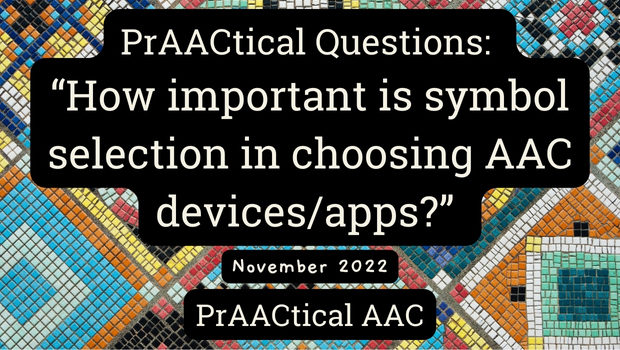PrAACtical Questions: “How important is symbol selection in choosing AAC devices/apps?”

They are often the first thing we notice in looking at a new AAC app or device. Are they realistic or minimalist? Overly juvenile or age respectful? Dull or appealing? Transparent, translucent, or opaque? Familiar or novel?
AAC symbols are among the many things that AAC practitioners have to think about when supporting people with significant communication challenges. Symbols are not the sexiest part of our AAC tools yet they play a critical role. Decisions about how to represent language should be made thoughtfully and with some data to justify our conclusions.
Symbol Sets vs Symbol Systems
Most AAC symbols are part of a set or collection. There are conventions for things like how movement is represented or how people are depicted, but there aren’t explicit rules governing how symbols are created.
Symbol systems, on the other hand, do have concrete rules for how they are developed and used. In Blissymbolics, for example, the elements of symbols have distinct meanings and rules for how they can be combined to symbolize words. The rules specify things like its size and placement (e.g., in the sky line vs earth line).
Rule-governed systems take longer to learn but are powerful once you understand them. It’s kind of like learning to read and write; it takes years to become literate but doing so yields immeasurable benefits. Once you know the rules of a system, two important things happen. One is that you have a way to decode unfamiliar symbols (e.g., if you know that a certain element symbolizes ‘action,’ you know that any symbol containing that element is likely to be a verb). The second is that knowing the rules allows you to create your own symbols for things that are novel or unique. This can also come in handy when you don’t know the symbol for a word you want to say. One of my first AAC clients combined ‘work’ and ‘stupid’ to create his own symbol for ‘chores.’ Many AAC professionals can share similar examples.
But does it really matter?
It depends. It doesn’t always matter which type of symbol is selected but sometimes it makes a difference.
The problem is, we don’t always know for whom the type of symbol really matters or under what conditions it plays a meaningful role.
- Despite being immersed in an AAC-friendly environment, Jenna hasn’t progressed with her SGD the way that her SLP, teacher, and parent hoped she would. Could a mismatch between her strengths and preferences and the SGD’s symbol set/system be part of the reason for her struggles?
- Siobhan seems to use her AAC app fairly well on most days, but when she’s stressed, tired, or unwell, she falters when navigating off of the main screen on her AAC app. She looks through the pages for action or describing words for long time, and seems frustrated as she searches for the word she wants. Is it possible that the symbols for those words play a role here? Would she do better on those days if we had chosen a different type of symbol?
Unless our decision included symbol assessment and was data-based, it’s hard to know.
In doing a feature match assessment for selecting AAC devices/apps, one of the characteristics that we look at is the types of symbols they use. Some professionals skip this step, either because they don’t feel it is important, they don’t know how to assess this feature, or they don’t have the time to investigate this. Nonetheless, symbol type is one of the features that differentiate one AAC app/device from another.
Many of us have struggled with the role of symbols in AAC decision-making. There is often some solid logic behind why professionals often choose not to evaluate this feature. Still, though, we think it deserves to be re-visited.
“It doesn’t matter what symbol type it is for their AAC system. The location on the board/screen will stay the same and that will help the AAC user find it even if they don’t know the symbol.”
There is no doubt that putting symbols in consistent locations is a boon to learning, but it’s not everything. Consider that AAC symbols are sometimes used outside of the actual communication board, book, app, or device. We label the room with them. Use them in teaching materials. Create templates and sentence frames with them. In those situations, communicators can’t rely on the location within a grid to decode symbol meaning. They have to look at the symbol itself to figure out what it represents.
“It doesn’t matter what type of symbol is used in their AAC system. This individual does equally well with all of them.”
That may be, but it’s important to check out this assumption and have data to back up the claim. After systematically evaluating performance with different symbol types, this may or may not be true. If it is, you can rely on other factors in the decision-making. Still, it doesn’t mean that symbols are interchangeable (see Using Multiple AAC Symbol Sets and Systems with AAC Learners: Considerations for Thoughtful Interventionists).
Even if their performance data is similar across symbol types, there’s another important factor to consider. How does the intended user feel about the various options? Do they have a preference for one over the others? This is worth exploring in a systematic fashion. In doing so, be sure to assess their preference not just for noun symbols but for a variety of word classes.
So what does all this mean?
A primary takeaway here is that there is often more than meets the eye in these situations. We should approach them thoughtfully, challenge our assumptions, and gather data to help in the decision-making.
::::::::::::::::::::::::::::::::::::::::::::::::::::::::::::::::::::::::::::::::::::::::
In the next post in this series, we tackle this prAACtical question: “What factors should we consider in choosing the symbol type for AAC?”
Filed under: Featured Posts, PrAACtical Thinking
This post was written by Carole Zangari
